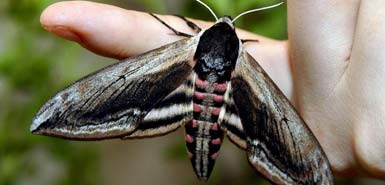tags: cyborg-moth, robotics, insects, warfare
 Would you think I was talking about a science-fiction novel if I told you that scientists can control the movements of a live moth using a joystick, and this moth was being used to spy on terrorist training camps in the hills of Pakistan? Just imagine; such a moth would be able to sit in a terrorist camp without arousing suspicion, while sending video and other information back to its homebase using a "reliable tissue-machine interface." But hey, apparently, this is not the stuff of science-fiction at all. In fact, this technology is being developed now and will be used at some point in the near future.
Would you think I was talking about a science-fiction novel if I told you that scientists can control the movements of a live moth using a joystick, and this moth was being used to spy on terrorist training camps in the hills of Pakistan? Just imagine; such a moth would be able to sit in a terrorist camp without arousing suspicion, while sending video and other information back to its homebase using a "reliable tissue-machine interface." But hey, apparently, this is not the stuff of science-fiction at all. In fact, this technology is being developed now and will be used at some point in the near future.
These "cyborg moths" are created by placing computer parts into the caterpillar so their nervous system grows around the parts, allowing the computer to control the behavior of the adult moth. These cyborg-moths have been described as one of the most ambitious robotics projects ever conceived by the Defense Advanced Research Projects Agency (Darpa), the research and development arm of the US Department of Defense (DoD).
"Moths are creatures that need little food and can fly all kinds of places," said Rod Brooks, director of the computer science and artificial intelligence lab at Massachusetts Institute of Technology (MIT). "A bunch of experiments have been done over the past couple of years where simple animals, such as rats and cockroaches, have been operated on and driven by joysticks, but this is the first time where the chip has been injected in the pupa stage and 'grown' inside it. Once the moth hatches, machine learning is used to control it."
Robotics is increasingly at the forefront of US military research, and remote-controlled moths, described by DARPA as Micro-Electro-Mechanical Systems, or MEMS, are one of a number of technologies soon to be deployed in combat zones.
"This is going to happen," said Brooks. "It's not science like developing the nuclear bomb, which costs billions of dollars. It can be done relatively cheaply."
Brooks has worked on robotic technology for more than 30 years. His company, iRobot, supplies the US military with robots that defuse explosive devices placed by insurgents. Apparently, robotic technology is working out so well that the military wishes to become more reliant on such "semi-autonomous" devices, including those that could fire a weapon.
"The DoD has said it wants one third of all missions to be unmanned by 2015, and there's no doubt their things will become weaponised, so the question comes: should they given targeting authority?"
Cited story.
- Log in to post comments

Hopefully our cyborg-moth overlords will eat bush and his cronies.
Quick, Henry, the Flit!
On its face it is interesting although I think it is disgusting to use animals in this way. First bugs, then what?
I can see another problem with this, though .... people will use this as an excuse to indiscriminately kill or poision all kinds of creatures, including moths under the auspices of protecting national (and personal?)security. Fear and paranoia that could be generated or nurtured could be another kind of "bomb".
That will be the end of endangered species and lots of others. Why worry about protecting habitat of spy creatures or potential spy creatures? If you want to convince your population that creatures should be destroyed and their habitat used for parking lots, just convince them the cockroaches, rats, cats, bears, lynx, birds, bugs.... have transmitters and are spying on them. Just kill all the creatures and you don't have to worry. And you don't even have to blame yourself! You can say - if it weren't for our enemies, we would not have to destroy our wildlife and natural areas! We only have to do it because our enemy MAKES us do it with their spy bugs!
Don't believe me?
Orwell was just a few decades off.
Clapping
Chardyspal
They already have :-)
Bob
The next stage is to use the moths to summon giant eagles.
This one has been kicking around for a while. The thing to realize is that the whole point of DARPA is precisely to fund "blue sky" stuff that's too weird for the regular science foundations. Every so often they get a real hit (like the ARPAnet), but a lot of those projects just don't work out -- and I wouldn't hold my breath for this one.
On the other hand, is anyone else flashing on Danny Dunn, Invisible Boy?
How come this isn't kept secret, I wonder? Terrorists can read the Internet, too, can't they?
Oh, I don't know. My work is in motor neuroscience (humans, not animals) and we understand a lot about the motor system already. It wouldn't surprise me if this took off relatively soon.
After all, it's been done with flies...
Despard: Oh, I don't mean to imply it couldn't be done in the lab... but it's a long way from there to turning it into a useful surveillance (or weapon-delivery) system.